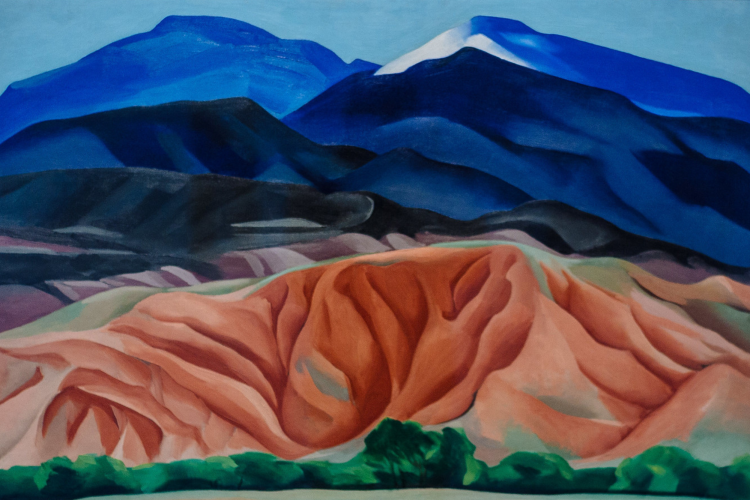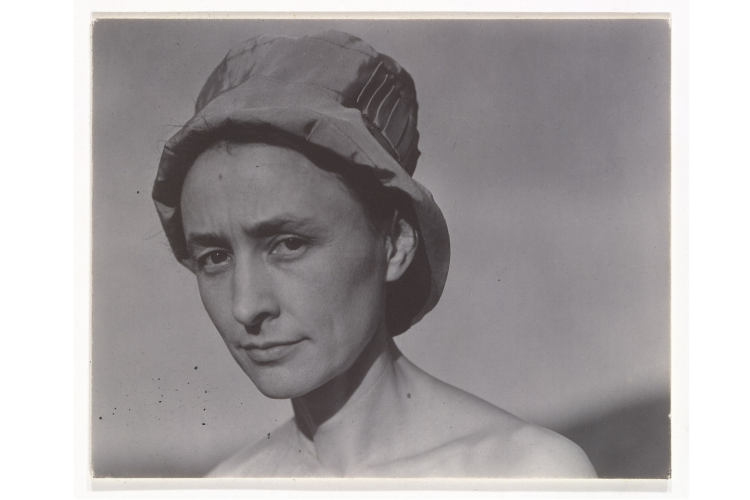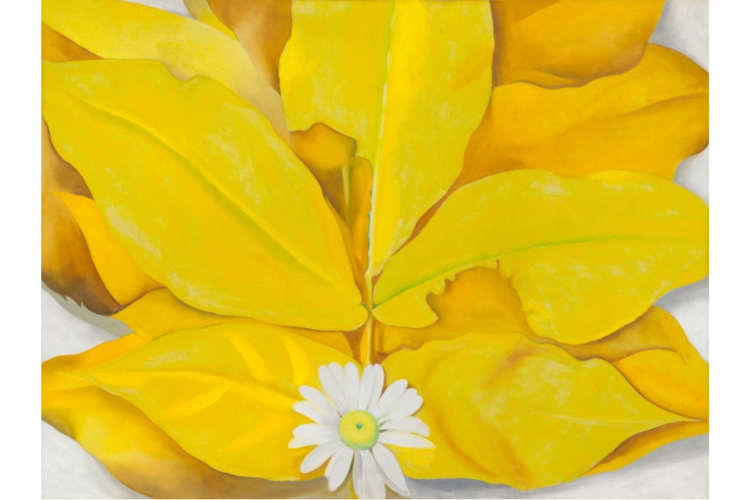13 Top Georgia O’Keeffe Paintings To Know in 2025

Entrench yourself in the fascinating and talented world of Georgia O'Keeffe paintings. Georgia O’Keeffe flower paintings and her abstractionist works are considered exemplary. She was a praised artist in her time and her pieces are prized to this day. Learn about Georgia O’Keeffe’s childhood, her death, her most expensive paintings and her lasting impact through her most impressive works.
Looking for Georgia O’Keeffe paintings for sale? There are many available at Christie’s auction house, ranging in price from under 2k to over 2 million. Read on and learn how to purchase your very own O’Keeffe (or just appreciate her amazing art in museums).
Jump to Section
Who Was Georgia O’Keeffe?

Georgia Totto O’Keeffe, born on November 15, 1887, was a pioneering American artist. Raised on a farm in Sun Prairie, Wisconsin, Georgia O’Keeffe’s childhood was characterized by her connection to nature and her family’s encouragement of her artistic skills. By 1905, she had set her sights on becoming an artist, studying at the Art Institute of Chicago and the Art Students League in New York. It was during this time that one of Georgia O’Keeffe’s first paintings, Dead Rabbit with Copper Pot, gained attention and won her a scholastic prize.
However, it wasn’t until she took a class at the University of Virginia that she developed her own truly unique style. There, she was exposed to the works of Arthur Wesley Dow and was encouraged to explore abstraction and move away from traditional painting methods. O'Keeffe developed her own distinct visual language, leading to her recognition as one of the most significant modern artists of the 20th century. Georgia O’Keeffe paintings are instantly recognizable. Her personal journey was rooted in experimentation and shaped her into a leading figure of American Modernism.
What Was Georgia O’Keeffe Famous For?
![Georgia O’Keeffe - Shell [1937]](https://res.cloudinary.com/hz3gmuqw6/image/upload/c_fill,q_5,w_750,f_auto/v1/classpop/blog/georgia-okeeffe-paintings-shell_67079c01ee1bd.jpg)
Georgia O’Keeffe gained fame for her groundbreaking contributions to modern art, most notably her large-scale, abstract depictions of natural elements, such as flowers and desert landscapes. In addition to her floral pieces, O'Keeffe painted New York skyscrapers in the 1920s, symbols of modernity in America. These works gained her immediate recognition.
It was her time in New Mexico, starting in 1930, that most profoundly influenced her art. There, she produced vivid representations of the stark desert landscape and local culture. This time period took place after O’Keeffe went to great lengths to establish herself as a consummate professional. It was in New Mexico that O’Keeffe began painting some of her most groundbreaking works. Her ability to evoke emotion through bold, simplified forms and colors made her a lasting icon of American art.
Many people ask, did Georgia O’Keeffe have children? O’Keeffe and her husband, photographer Alfred Stieglitz, believed that children would harm their ability to create art and lead their preferred lifestyles. As such, O’Keeffe never had any children. Her legacy is one of impactful, innovative art that has inspired generations, making Georgia O’Keeffe paintings some of the most praised in the art industry.
Why Did O’Keeffe Stop Painting?

Similar to other famous artists, Monet and Cassatt, O’Keeffe’s painting career was eventually hindered by her deteriorating eyesight. In the 1950s, she began to suffer from macular degeneration, a condition that impaired her vision. By 1972, she was no longer able to create oil paintings without assistance. Despite this, her drive to create persisted. Even as she lost her sight, she continued to produce art with the help of assistants, focusing on drawing from memory and her imagination.
What was Georgia O’Keeffe’s famous quote? The Art Institute of Chicago displays an excellent O'Keeffe quote that exemplifies her resolute nature, “I’ve been absolutely terrified every moment of my life and I’ve never let it keep me from a single thing that I wanted to do.” O'Keeffe’s enduring spirit remained strong her entire life even as her later physical limitations threatened to stop her from painting — the Georgia O’Keeffe paintings kept coming.
How Did Georgia O’Keeffe Die?
Georgia O’Keeffe lived a long and vibrant life, passing away on March 6, 1986, at the age of 98 in Santa Fe, New Mexico. Although she experienced significant health challenges in her later years, including her nearly complete blindness, O’Keeffe’s artistic legacy endured. Her death marked the end of an era, but all the Georgia O’Keeffe paintings made a massive contribution to modern art and continue to be celebrated worldwide.
We encourage you to gain further appreciation for O’Keeffe’s skills by taking in person or online painting classes. Additionally, learn about other famous artists of the 20th century, and learn to appreciate Warhol paintings, Frida Kahlo paintings, Thomas Kinkade paintings, Andrew Wyeth paintings and more.
Best Georgia O Keeffe Paintings
How many paintings did Georgia O’Keeffe paint? She produced over 2,000 pieces of artwork in her time. The works highlighted below are considered to be some of her best.
1. Jimson Weed (1936)

What was Georgia O'Keeffe's most important painting? Undoubtedly, Jimson Weed is in the running for this accolade. It depicts a close-up of a white flower against a neutral background. Known for her large-scale floral works, O’Keeffe magnified the bloom to highlight its beauty and intricate details, giving it a striking presence. This painting reflects her fascination with nature and ability to transform something as simple as a flower into an evocative work of art. This painting is housed in the Indianapolis Museum of Art. If your sweetheart loves Georgia O'Keeffe paintings, take them for a visit as a thoughtful experience gift in Indianapolis.
2. Pedernal (1941)

Georgia O’Keeffe paintings often feature the rugged landscapes of New Mexico, and Pedernal is a perfect example. This 1941 painting focuses on the flat-topped mountain that O’Keeffe could see from her New Mexico home, a subject she revisited many times in her career. Her use of simplified forms and vibrant colors captures the majesty and tranquility of the landscape, turning Pedernal into a personal symbol. The painting is now part of the Georgia O’Keeffe Museum collection, which continues to preserve her rich connection to the Southwestern landscape.
3. Red Canna (1923)

Red Canna is one of the most celebrated Georgia O’Keeffe paintings, known for its vivid depiction of a flower rendered in vibrant reds, oranges and yellows. This 1923 painting represents her fascination with magnified floral forms and abstract shapes, giving the viewer a sense of being hugged by the petals. The swirling, energetic movement within the composition evokes both the beauty and power of nature. Currently, this masterpiece resides in the collection of the Amon Carter Museum of American Art, where it continues to captivate audiences with its bold interpretation of nature.
4. Sky Above Clouds IV (1965)

This is one of the cloud series Georgia O’Keeffe paintings. It takes the viewer to a new dimension, as she begins to explore aerial perspectives. Painted in 1965, Sky Above Clouds IV is a large-scale work that presents a horizon filled with billowing clouds viewed from an airplane’s perspective. The simplified shapes and subtle gradations of color reflect O’Keeffe’s ability to capture the feeling of vastness. This monumental painting is now part of the Art Institute of Chicago’s collection.
5. Lake George [formerly Reflection Seascape] (1922)

Lake George is one of the earliest Georgia O’Keeffe paintings depicting the serene beauty of the landscape surrounding Alfred Stieglitz’s family estate in upstate New York. This 1922 painting features soft hues and an almost abstract depiction of water, sky and land, showcasing her evolving style as she shifted toward abstraction. The peaceful composition reflects her deep connection to the natural world and her keen eye for capturing its subtle variations. Currently, this painting is housed in the San Francisco Museum of Modern Art, preserving her legacy of blending realism and abstraction.
6. The Beyond (1972)

Georgia O’Keeffe paintings, later in her career, often reflected her fascination with vast, open spaces. The Beyond (1972) is one such work, portraying a distant horizon over an expanse of light and color. The painting evokes a sense of infinite space, a theme that preoccupied O’Keeffe as she aged and continued to push the boundaries of her artistic expression. Part of the Georgia O’Keeffe Museum’s collection, this piece is a profound representation of her ability to convey spiritual depth and a connection to the broader universe through her art.
7. From the Lake (1924)

This is one of the notable Georgia O’Keeffe paintings inspired by her time at Lake George in New York. The painting presents an abstract view of the water, using swirling forms and flowing lines to convey the movement and energy of the lake. The rich blues and greens give the work a sense of depth and fluidity. This painting is now housed in the Art Institute of Chicago, where it exemplifies O’Keeffe’s masterful ability to blend abstraction with elements of nature.
8. Oriental Poppies (1928)

In Oriental Poppies (1928), Georgia O’Keeffe painted a close-up of two bright red poppies that seem to explode with color. The painting is a quintessential example of her fascination with magnifying natural subjects to reveal their intricate beauty. The vibrant reds and deep blacks create a powerful contrast that captures the viewer’s attention. This is one of the only Georgia O’Keeffe paintings that's housed at the Weisman Art Museum in Minneapolis.
9. Music Pink and Blue (1918)

Music Pink and Blue (1918) is one of the earliest Georgia O’Keeffe paintings that exemplify her exploration of abstraction. The swirling, soft forms in shades of pink and blue suggest the rhythm and movement of music, an inspiration for much of her work during this period. The painting represents her departure from realism and her embrace of a more fluid style. Currently part of the Whitney Museum of American Art’s collection, this work highlights O’Keeffe’s early success in developing a unique and innovative approach to modern art.
10. Abstraction White Rose (1927)

This is one of the Georgia O’Keeffe paintings of flowers. In it, she depicts an abstract form of a flower to create an interplay of light and shadow. The soft, swirling petals of the white rose blend together in delicate gradients of white and gray, giving the piece a dreamlike quality. This work showcases O’Keeffe’s fascination with nature’s organic forms, while also highlighting her mastery of color and composition. The painting is now part of the Georgia O'Keeffe Museum collection, where it continues to inspire viewers.
11. Cow's Skull with Calico Roses (1931)

Cow's Skull with Calico Roses (1931) is a striking example of Georgia O’Keeffe paintings that merge symbolism and the natural world. Here, she embraces the uniformity of a white cow’s skull with white calico roses. You may have seen recreations of this painting in striking colors. This work reflects her fascination with the desert landscapes of New Mexico and the symbolism she found in the objects she encountered there. The artwork is now housed at The Art Institute of Chicago. It illuminates her unique approach to combining realism with abstract and symbolic elements.
12. Yellow Hickory Leaves with Daisy (1928)

Discover one of the Georgia O’Keeffe paintings that reflect her deep and lasting connection to nature. In this painting, she carefully arranges yellow hickory leaves around a single white daisy, creating a harmonious composition that emphasizes the beauty of simple natural forms. The use of warm, autumnal colors highlights her mastery of color and composition, creating a work that is both elegant and serene. This painting is part of The Art Institute of Chicago collection.
13. Above the Clouds I (1963)

Above the Clouds I (1963) is a significant piece among Georgia O’Keeffe paintings, showcasing her exploration of aerial perspectives. The painting features an expansive view of soft, floating clouds beneath a pale sky, giving the viewer a sense of flying above the earth. The simplified forms and muted colors reflect her later work’s focus on atmosphere and space. This painting is part of the Georgia O’Keeffe Museum’s collection, exemplifying her ability to capture the vastness and serenity of the natural world even as her vision began to fade.
Georgia O’Keeffe’s legacy is undeniably one of the most significant figures in modern art. Her bold, innovative approach to abstraction and her deep connection to nature allowed her to create works that transcended the boundaries of traditional painting. O’Keeffe was a true pioneer. We encourage you to view her works for yourself.
For even more fun art gift ideas, check out other experiences happening on Classpop!

